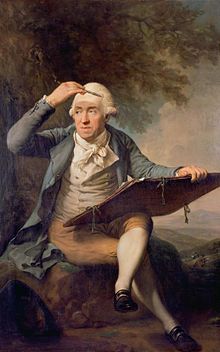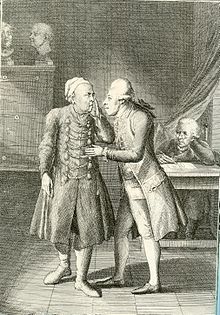Adrian Zingg

Adrian Zingg (born April 15, 1734 in St. Gallen ; † May 26, 1816 in Leipzig ) was a Swiss painter , draftsman , etcher and engraver . He was a pioneer of the newer Dresden landscape painting.
Life
Adrian Zingg received his early training from his father, the steel cutter Bartolomäus Zingg, and then went on to do an apprenticeship with the copper engraver Johann Rudolf Holzhalb in Zurich. In 1757 he worked for the Bernese vedute painter Johann Ludwig Aberli , who made him a. a. Views from Switzerland. Together with the medalist Johann Caspar Mörikofer from Bern both traveled to Paris in 1759, where Zingg spent seven years a. a. worked for the engraver Johann Georg Wille .

In 1764 he was appointed by Christian Ludwig von Hagedorn as a copperplate engraver at the newly founded Dresden Academy , where he worked as a teacher from 1766. He had an intensive exchange with the professor at the Dresden Academy Christian Wilhelm Ernst Dietrich , who acted as mentor for Zingg. In 1774, after Dietrich's death, Zingg began to complete his late prints and published a complete edition of 87 sheets. In 1769 he also became a member of the Vienna Academy and in 1787 a member of the Berlin Academy . In 1803 he was appointed professor of copper engraving at the Dresden Academy, and he also held the title of electoral court copper engraver. Zingg's most famous students included Carl August Richter and his son Ludwig Richter , as well as Heinrich Theodor Wehle and Christoph Nathe .
Adrian Zingg was best known for his landscape paintings in sepia technique . He concentrated on the representation of the Thuringian Forest, parts of Bohemia and especially Saxon Switzerland, which he had wandered through in the 1780s and 1790s. Together with his friend Anton Graff, Zingg is the creator of the name Saxon Switzerland for the Elbe Sandstone Mountains . Both felt reminded by the landscape of their homeland, the Swiss Jura , in which similar landscapes can be found.
meaning
The aim of Zingg's representations was the greatest possible accuracy in rendering the landscapes. The student Zinggs Ludwig Richter criticized its mannerist design in his memoirs . Although Zingg enjoyed a high reputation among his contemporaries, his works were often found to be artistically inferior after his death. Nevertheless, for today's viewer they are not only of interest as documents of Saxon local history. Today, Zingg is seen as an important pioneer and initiator of the Dresden Romanticism and influenced artists far beyond his circle of students, such as Caspar David Friedrich , through his choice of motifs and his romantic, transfigured view of real landscapes .
plant
- Adrian Zinggs Kupferstichwerk , Tauchnitz, Leipzig, 1805 (comprising 52 engravings)
gallery
Honors and exhibitions
- Dresden was the district Mickten the Zinggstrasse named after Adrian Zingg.
- In 2012 the Staatliche Kunstsammlungen Dresden and the Kunsthaus Zürich dedicated an exhibition to the artist for the first time .
literature
- Johann Kaspar Fuessli: History of the best artists in Switzerland . Volume 3. Orell, Zurich 1770, pp. 230-239.
- Hermann Arthur Lier : Zingg, Adrian . In: Allgemeine Deutsche Biographie (ADB). Volume 45, Duncker & Humblot, Leipzig 1900, p. 323.
- Sabine Weisheit-Possél: Adrian Zingg (1734-1816). Landscape graphics between Enlightenment and Romanticism . LIT Verlag, Münster 2010, ISBN 978-3-643-10361-1 .
- Staatliche Kunstsammlungen Dresden, Kupferstich-Kabinett; Petra Kuhlmann-Hodick; Claudia Schnitzer; Bernhard von Waldkirch (Ed.): Adrian Zingg. Trailblazer of Romanticism . Sandstein Verlag, Dresden 2012, ISBN 978-3-942422-86-4 .
Web links
- Marc Fehlmann: Zingg, Adrian. In: Historical Lexicon of Switzerland .
- Anke Fröhlich: Zingg, Adrian . In: Institute for Saxon History and Folklore (Ed.): Saxon Biography .
- Adrian Zingg. Trailblazer of Romanticism
- Peter Wegmann: Zingg, Adrian. In: Sikart (status: 2018), accessed on February 23, 2018.
Individual evidence
- ↑ JF Linck: Monograph of the painterly images erased, scraped and cut into wood by the… court painter and professor… CWE Dietrich: along with an outline of the artist's life story . Berlin 1846, p. 35ff.
- ↑ British Museum website
| personal data | |
|---|---|
| SURNAME | Zingg, Adrian |
| BRIEF DESCRIPTION | Swiss painter |
| DATE OF BIRTH | April 15, 1734 |
| PLACE OF BIRTH | St. Gallen |
| DATE OF DEATH | May 26, 1816 |
| Place of death | Leipzig |


